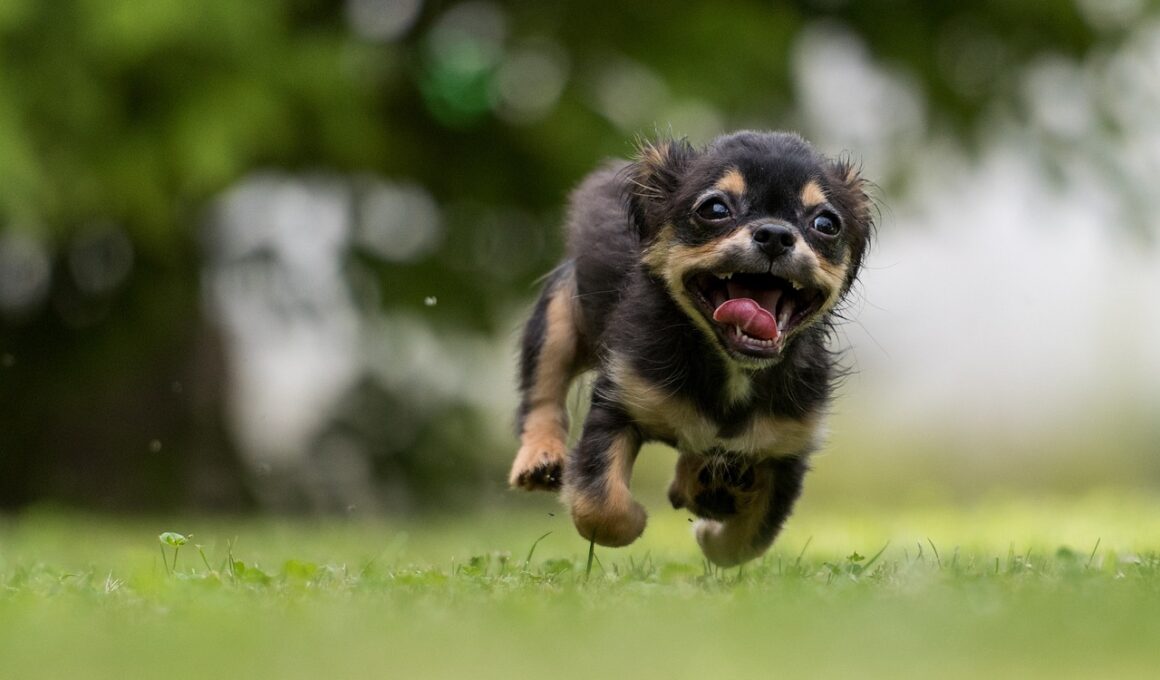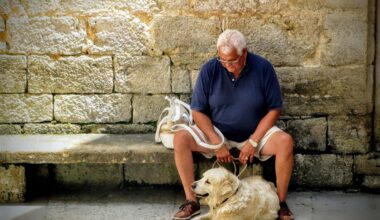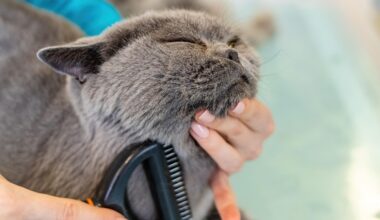Understanding Filter Intensity in Dog Photos
Dog photography can greatly benefit from the use of filters, allowing photographers to manipulate light and color in a desired fashion. Filters serve various purposes, such as enhancing vibrancy, reducing glare, and creating specific artistic effects. Understanding filter intensity is crucial for getting the most out of your photography. Strong filters might produce dramatic changes in color saturation while others create subtle adjustments. Learning how to control these variations will allow you to better highlight your canine subject’s personality and expression. For instance, a polarizing filter can help cut out reflections on wet fur for a clearer image. Conversely, a warming filter can impart a golden hue, perfect for capturing a dog’s playful nature during dusk shoots. To properly utilize these tools, it’s essential to experiment with various filter types available on the market. Testing various intensities on different days can yield valuable insights into how each filter interacts with nature’s light. Make sure to document settings to create a reference for future sessions. Overall, incorporating filters thoughtfully in your dog photography can vastly improve the final image quality.
Different types of filters—like ND filters, polarizers, and color filters—offer unique outcomes, helping enhance the overall quality of dog photos. Neutral Density (ND) filters are particularly effective for controlling exposure and allowing longer shutter speeds even in bright lighting conditions. This can be advantageous when seeking to capture the motion of your pet running or jumping. Additionally, polarizing filters reduce reflections and enhance color contrast, making your subject pop amidst a heavy backdrop. Such effects are especially notable in outdoor settings, where natural light can overpower the subject. Moreover, color filters can add mood and depth to your photographs. For instance, a blue filter can evoke a cool, serene atmosphere, ideal for a calm dog portrait. Conversely, using an orange filter can brighten the image, creating a warm feeling that resonates during sunset. Testing these filters under various conditions helps understand their true potential. By finding the right balance in filter intensity, you can elevate your photography from ordinary captures into stunning works of art. Always remember, post-processing can also enhance the effects of filter use, blending both techniques for a final masterpiece.
The Role of Polarizing Filters in Dog Photography
When capturing dog photos in bright outdoor environments, polarizing filters can be an indispensable tool. They help eliminate reflections, resulting in clearer images, especially when shooting near water sources. By reducing glare on the dog’s wet fur or nearby surfaces, the filter enhances colors and levels of detail. To maximize effectiveness, rotate the polarizer until the desired effect is achieved. As a result, you may notice your dog’s coat appearing more vibrant and defined against its surroundings. In addition to beautifying the subject, polarizing filters also help in enhancing the sky’s color, offering a stunning backdrop for your pet portraits. This dynamic contrast brings depth to the photograph, making it more captivating. However, it’s essential to remember that polarizers reduce light entering the lens; hence, adjustments to camera settings might be necessary. Proficient photographers often combine this filter with natural light timing—early morning or late afternoon—to achieve exquisite soft lighting. By understanding the polarizes’ unique qualities, you can explore new dimensions in capturing your beloved dog’s personality in striking visuals.
Light can be an unpredictable aspect of dog photography, which is where neutral density (ND) filters come into play. These filters allow for better light management without affecting color outputs, making them ideal for bright conditions. By reducing the amount of light that hits the camera sensor, photographers can work with slower shutter speeds. This capability is especially useful when capturing action shots of playful dogs engaging in activities like running or jumping. The resulting images can demonstrate movement beautifully, with a silky smooth background blur while keeping the focus squarely on your furry friend. There are different strengths of ND filters categorized by their density levels; lower ND ratings reduce light slightly, allowing for minor adjustments. On the other hand, high-density filters can greatly diminish light, making them suitable for extremely bright conditions or when photographers desire longer exposures. Photographers seeking to venture into long-exposure dog shots should experiment with varying ND filter intensities. This exploration can significantly improve their skills and results. Ultimately, understanding ND filters can effectively transform how everyday moments with dogs are captured.
The Use of Color Filters for Mood Enhancement
Using color filters in dog photography offers a fascinating way to evoke emotion and enhance mood within your images. A color filter can alter the overall tone of an image, dramatically transforming its atmosphere. For instance, employing a warm filter can create feelings of happiness and warmth, while cooler tones may elicit calmness or serenity. The key to successfully using color filters lies in understanding the context of your shot and the character of the dog you are shooting. A vibrant red filter may be lovely for a high-energy dog at play, while a cooler blue filter would better suit a more thoughtful or serene canine portrait. Experimenting with these various filters allows you to discover how they enhance the storytelling aspect of your imagery. Additionally, layering multiple color filters can produce unique results, further expanding your creative possibilities. This technique creates a mesmerizing blend of colors, delivering artistic and striking visuals of your furry subjects. As always, test the effects before an important shoot, ensuring the right mood is captured to reflect each dog’s personality beautifully.
Incorporating effective techniques for using filters in dog photography involves understanding their correct setup and adjustments in post-processing. While filters undeniably enhance images, achieving optimal results also hinges on initial camera settings and lighting conditions. Using manual mode for adjustments grants more flexibility, allowing photographers to experiment with exposure, shutter speed, and aperture. Capturing in RAW format further facilitates greater control during post-processing stages. This method enables you to modify light and color qualities without compromising the shot’s integrity. After capturing your dog photographs, take time to review and enhance them using photo-editing software. This step is crucial: filters may not always make the changes perfect but lay a foundation for final adjustments. For example, you might boost saturation slightly to emphasize colors brought out by a polarizing filter. Explore contrast and brightness enhancements to give your images an eye-catching finish. Remember that every filter combined with specific adjustments holds the potential for unique results. Use these elements together to reflect the playful spirit and energy of dogs, achieving striking photographs that resonate with viewers.
Final Tips on Using Filters in Dog Photography
Ultimately, a successful dog photography session hinges on a thorough understanding of your filters coupled with patience and practice. Each photographer will find personal preference in filter types and settings, yet key principles remain consistent. Always take the time to plan your shoot, checking your equipment, and having a variety of filters on hand for every situation. Backgrounds play an important role as well; consider how filters enhance or complement the environment. Always be open to experimenting with various settings, learning how adjustments impact the overall outcome. Letting your furry subject move naturally without forcing poses often results in the most authentic and compelling images. The goal should be to capture the spirit and personality of the dog while appreciating their unique beauty. Whether you’re in a park or your backyard, your environment can elevate the storytelling aspect of the shot. With dedication and exploration, the art of dog photography can become a rewarding and enriching journey. As you develop techniques with filters, your photos will evolve, painting vivid portraits of the incredible bond shared with dogs.
This exploration of filters and their usage demonstrates how thoughtful application can transform ordinary dog photographs into extraordinary captures. Observing a few nuanced guidelines ensures photographers maximize their equipment’s potential. Understanding light, adjusting settings, and utilizing filters together creates a solid foundation for capturing stunning dog portraits. Don’t shy away from experimenting, as every shoot fosters learning and improvement, refining individual techniques. Invest time into understanding filters, seeing how various intensities elicit different outcomes in your work. Gaining experience will empower you to make informed decisions on when and how to employ filters effectively. Revisit favorite locations and recognize how unique light conditions require an adaptive mindset towards using your filters. Capture dynamic moments while being agile enough to switch filters or settings mid-shoot when necessary. The key lies in allowing your creative vision to shape the results, consistently pushing boundaries to discover new perspectives. As you grow in your photography, the joy of capturing your dog in various settings will create cherished memories, inviting viewers into the shared experience. Ultimately, capturing the essence of the bond with your canine companion can be a beautiful, lasting legacy.


